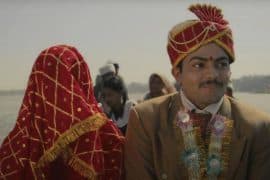According to an estimate, approximately fourteen million Indians visit cinemas daily to watch films. In 2012 alone, Bollywood sold around 2.6 billion tickets as opposed to Hollywood’s 1.36 billion tickets. This article attempts to look into how Indian Cinema came into being and has evolved over the decades to become what we binge-watch on our screens every day now.
Cinema as an art and aesthetic has always been integral to Indian culture. More than that, some would even go on to call it a predilection which connects us Indians, in a rather transcendental manner. Most of us feel connected anywhere and everywhere because of these shared memories – then be it the uncountable times when Raj swept us off our feet or Amir’s Pehla Nasha, we all mutually yet exclusively share the sentiment. From artists to celebrities, big screens to web series, the stereotyped hero to the now not-so-conventional protagonists – Hindi cinema has infused distinct colors in all of our lives.
https://twitter.com/FilmHistoryPic/status/1357970141200449536
- Let’s turn through the pages a little bit to set the tone for this inexplicable journey that we are going to look into, shall we?
The history of Indian Cinema goes back to the nineteenth century. In 1896, the very first films shot by the Lumiere Brothers were shown in Mumbai (then Bombay). It was not much later that Dada Saheb Phalke, a scholar of Indian languages and culture ventured India’s foremost full-length silent Marathi film, ‘Raja Harishchandra’ in 1913, and thereby laid the foundation of a regular feature film industry in India. India’s first talkie, ‘Alam Ara’, directed and released by Ardeshir Irani in 1931 was an instant hit and paved way for future successes.
Satyajit Ray’s classic film ‘Pather Panchali’ released in 1953 proved to be a major breakthrough for the Indian film industry in the global scene that won the reputed Cannes award in the best film category and led to several international and domestic honors and awards. Several films from that era, for e.g. Bimal Roy’s ‘Do Bigha Zamin’, Mehboob Khan’s ‘Mother India'(1957), Raj Kapoor’s ‘Shree 420’ (1955) and ‘Awaraa'(1951), Guru Dutt’s ‘Pyasa'(1957) and Kaagaz Ke Phool (1959), set new records at the box office. These films highlighted social themes mainly dealing with the working class. Ever since the social realist film Neecha Nagar won the Grand Prize at the first Cannes Film Festival, Hindi films were frequently in competition for the Palme d’Or at the Cannes Film festival throughout the 1950s and early 1960s, with some of them winning major prizes at the festival.
The Golden Age
The late 1940s to early 1960s are what the film historians refer to as the Golden Age of Hindi Cinema. Parallel Cinema, an alternative to the mainstream Indian cinema, originated in Bengal in the 1950s. It is known for its serious content realism and naturalism. The social films of V. Shantaram, more than anything else, paved the way for an entire set of directors who took it upon themselves to interrogate not only the institutions of marriage, dowry, and widowhood, but the grave inequities created by caste and class distinctions. Some of the social problems received their most unequivocal interpretation and expression in Achhut Kanya (“Untouchable Girl”, 1936), a film directed by Himanshu Rai of Bombay Talkies. Bimal Roy’s ‘Do Bigha Zamin’ (1953), which shows the influence of Italian neo-realism, explored the hard life of the rural peasantry under the harshest conditions.
https://twitter.com/FilmHistoryPic/status/1358419024934240259
In the meantime, the Hindi cinema had seen the rise of its first acknowledged genius, Guru Dutt, whose films critiqued the conventions of society and deplored the conditions which induce artists to relinquish their inspiration. From Barua’s Devdas (1935) to Guru Dutt’s ‘Sahib Bibi Aur Gulam’ (1962), the motif of “predestined love” remained in the epicentre with a mawkish sentiment characterising even the best of the Hindi cinema before the arrival of the new or alternative Indian cinema in the 1970s.
The Masala Movies and Trendsetters
By mid-seventies, love stories gave way to the violent action themes about gangsters. Hindi Cinema, more or less came to be characterised by conventional and stereotypical storylines, item numbers, and verbose drama. Amitabh Bachchan is the iconic star known for his angry young man roles. He dominated the silver screen with other male leads like Mithun Chakraborty and Anil Kapoor and female actresses including Hema Malini, Jaya Bachchan and Rekha for several years. The 1970s, thus marked the upsurge of commercial movies with trendsetter films such as Sholay (1975). Some would even go on to call the seventies, the era of the advent of ‘masala movies’ in Bollywood. The prominent actor and director, Manmohan Desai became the father of such Masala movies –
“I want people to forget their misery. I want to take them into a dream world where there is no poverty, where there are no beggars, where fate is kind and god is busy looking after its flock.”
In the late eighties and early nineties, once again the trend changed in Indian cinema and there was a marked shift from gangster movies to romantic musicals. Family-oriented films such as Mr India (1987), Qayamat Se Qayamat Tak (1988), Maine Pyar Kiya (1989), Hum Aapke Hain Kaun (1994) and Dilwale Dulhania Le Jayenge (1995). A new breed of stars emerged from these films including Aamir Khan, Salman Khan, Shahrukh Khan, Sridevi, Madhuri Dixit, Juhi Chawla and Kajol. It was also the age of action and comedy cinema and film stars such as Govinda and Akshay Kumar and actresses like Raveena Tandon and Karisma Kapoor often cast for the particular genre of the films.
https://twitter.com/FilmHistoryPic/status/1358718854529179649
Return to Political Sensibility
The nineties was known for the launch of unique artists and independent filmmakers who also acquired commercial success with critical acclaim. Satya (1998), directed by Ram Gopal Varma and written by Anurag Kashyap was the best example of it which marked the beginning of a distinctive films category recognized as Mumbai noir, metropolitan flicks projecting societal issues in Mumbai city.
Ghatak went on to serve as Director of the Film and Television School at Pune, from where the first generation of a new breed of Indian film-makers and actors – Naseeruddin Shah, Shabana Azmi, Smita Patil, and Om Puri among the latter was to emerge. These film-makers, such as Shyam Benegal, Ketan Mehta, Govind Nihalani, and Saeed Mirza, exhibited a different aesthetic and political sensibility and were inclined to explore the caste and class contradictions of Indian society, the nature of oppression suffered by women, the dislocations created by industrialism and the migration from rural to urban areas, the problem of landlessness, the impotency of ordinary democratic and constitutional procedures of redress, and so on.
The 2000s: Our-Generation-Cinema
The decade of 2000s saw significant changes in terms of the cinematography, storylines, artists, and even the themes explored. Hindi Cinema witnessed a gradual digression back to the themes of exploring the day-to-day lives and challenges of the common man, so much so that the masculinist macho Raj Kapoor of Rab Ne Bana Di Jodi became Balram, the drop-out from The White Tiger. The focus, then, became not turning it into the dreamy blockbuster but an artwork that can resonate with the working middle-class. The leading production houses in India including Yash Raj Films and Dharma Productions experimented with innovative contemporary films such as Kal Ho Naa Ho (2003), Chak De India (2007), and My Name is Khan (2010). Danny Boyle’s Slumdog Millionaire (2008), which has won four Golden Globes and eight Academy Awards, was also directly inspired by Bollywood films and is considered to be a homage to Hindi commercial cinema.
https://www.instagram.com/p/B9jTbWpIYqb/?igshid=7qk5xwcpkm2u
https://www.instagram.com/p/B6vbJJOoWd6/?igshid=abn3py1hmfi6
With the Hindi Cinema resonating with not only the people within Indian borders but also beyond, the picture has drastically shifted in contemporary times. Newer broadcast mediums such as Alt Balaji, Hotstar, Amazon Prime, and Netflix, Indian Cinema has something in store for each and every one of us – every genre, every sentiment. The advent of new pop culture terminologies such as “binge-watch” and “Netflix and chill” has made possible for both the filmmakers and the audience to explore and experiment with unconventional belief systems and artforms, paving way for new normatives. For instance, the recent Netflix buzzes The White Tiger and Sir explore an unconventional protagonist, alternative storylines and breaking out of the stereotypical taboo systems.
Perhaps, instead of calling it a new normative, it can also be looked at as returning to our roots instead. From Lagaan (2001) and Rang De Basanti (2006) to Tamasha (2015) and Thappad (2019) – all break free of the conventional set norm to venture into what really needs to be talked about, something that not only resonates with the common man but also leaves space for discursive ideas and advancement. Pink (2016), Lipstick Under My Burkha (2016), Badhaai Ho (2018), Mardaani 2 (2019) and the list goes on.
From giving us romance goals like Raj Kapoor in the 40s to portraying six-pack abs as a must-have for the primary male protagonist like John Abrahams and Salman Khan to eventually venture back into the idea of exploring with unconventional storylines only to break out of the norm and create relatable binge-worthy content – Indian Cinema has come a long way. Now our lead can be just as lost as we are, trying to make sense of what life is like our Ved of ‘Tamasha’ or as ambitious as Balram of The White Tiger whose only intention is to rise up the social ladder and make a name for himself (pretty much all that we are trying to do here)! Even women characters have gradually stepped out of the confines of their kitchens and homes to venture into more humane powerful personas like Priya of Kya Kehna (2000) who is resilient at the face of “log kya kahenge”, Shashi of English Vinglish (2012) who steps out of her confines to regain her identity, Rani of Queen (2014) with roaring hopes and aspirations, Pink (2016) telling the nation that when a woman says ‘no’, it means ‘no’, and Amrita of ‘Thappad’ (2020) who steps out of her seemingly perfect life to ask uncomfortable questions.
Therefore, a considerable amount of credence for infusing Hindi Cinema with an altogether new life, sentiment and diaspora goes to the OTT and one can only wonder what else does this enormous abode of talent, art, and impressions has in store for us.
Image Credits – CitySpidey.com
Annanya Chaturvedi





Comments are closed.